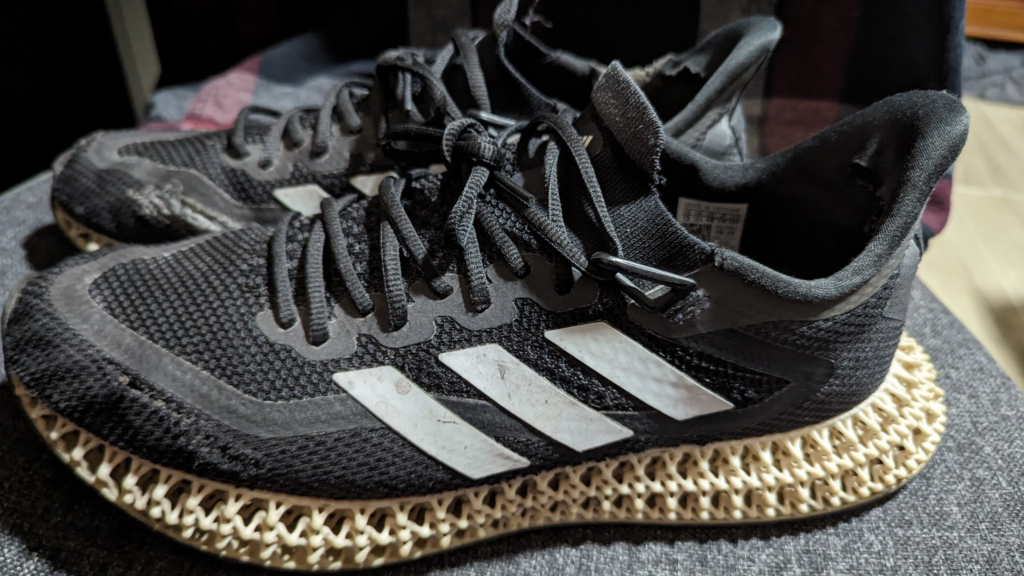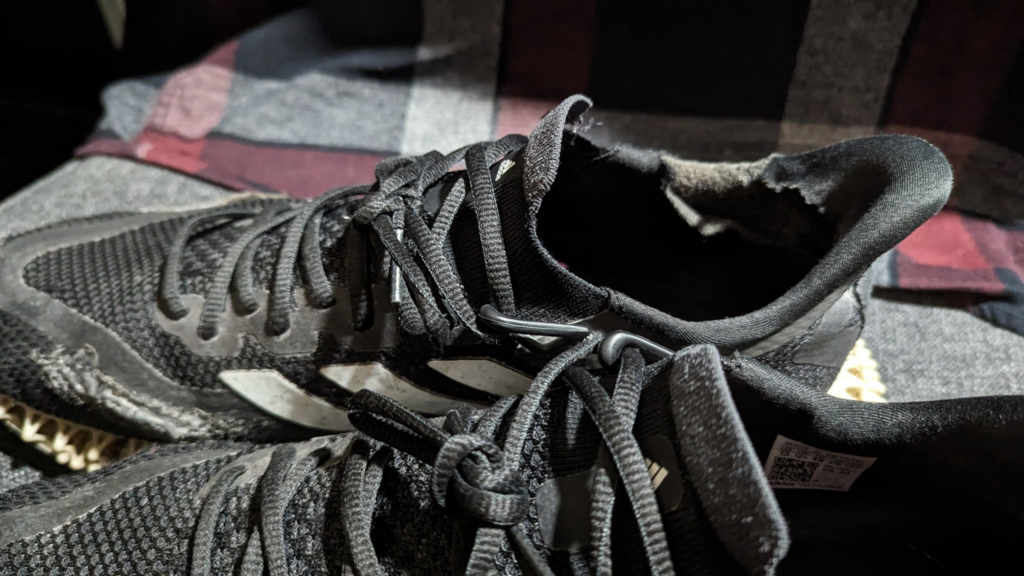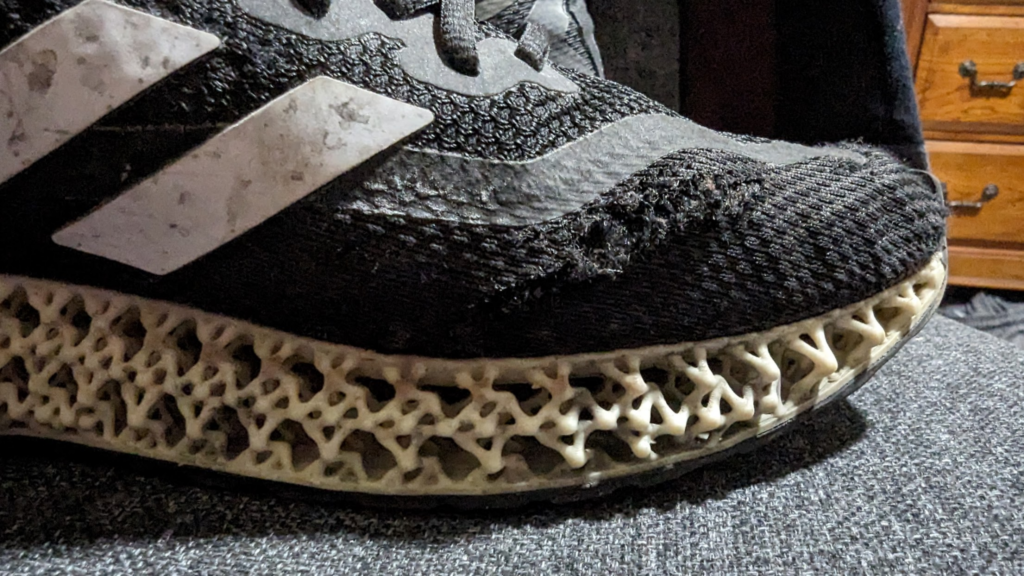I have been entranced with 3D printing since 2014, when I was just 14 years old. Ever since I learned about this technology, I have wondered if we could eventually make accouterments. Fast forward to December 2016 and adidas was announcing a limited-edition shoe with a 3D printed midsole. Ever since then, I wanted to get my hands on a pair. With the launch of the more widely released 4DFWD line in 2021, I was set to seek them out. I soon found a pair at Dicks Sporting Goods and, after spending the last year with them, I was able to determine just how well they’ve held up throughout my everyday life.
Behind the Shoe
The 4DFWD shoe line is the result of a long-standing partnership between the athletic wear giant and Carbon, a Silicon Valley-based startup that pioneered a form of additive manufacturing (AM) it refers to as Digital Light Synthesis (DLS). This form of continuous vat photopolymerization has allowed adidas to 3D print midsoles at scale, demonstrating one of the most successful uses of AM in the consumer space.
A 3D Printing Professional’s Perspective
Before I continue, I would like to acknowledge my personal biases. I was previously a 3D print technician and production manager for online AM bureau makexyz and recently joined Arizona-based 3D printing service A3D Manufacturing as a print technician. It’s not the most physically demanding job, but it’s no office gig either. We are frequently exposed to chemicals, dyes, and sharp debris from printed supports. With that in mind, I have to acknowledge that I have and will continue to be very involved in the 3D printing industry. I want all of the sector’s products and processes to succeed, so I am aiming to convey a neutral point of view, while pointing out flaws in order to create a better product.
 Image courtesy of adidas
Image courtesy of adidasComfort
The partnership between adidas and Carbon has created the most comfortable pair of shoes that I have ever worn—period. With the intricate lattice of the midsole and the super breathable fabric, these shoes stand in a league of their own. I used to get major back pain after standing all day wearing other products, but this wasn’t the case with adidas. The whole shoe was extremely supportive, and, as my wife informed me, “They help you stand up straighter.”
Since my adidas shoes are so patched and worn, I thought I’d go back to my previous pair of New Balances. Based on many opinions, this competitive brand offers the most supportive and comfortable footwear. As soon as I wore them to work, however, I was greeted with a return of back pain and an overall discomfort in my feet. I immediately reverted to my exhausted 3D printed shoes, only to witness my pain vanish once more. adidas and Carbon have really created a revolutionary product.
Durability
Carbon has done something that not many in the world know is possible. They created a material that is durable enough to last through everyday life. These shoes have seen mud, sand, snow, and the hot Arizona asphalt in August, along with a variety of dyes and other chemicals. The 3D printed midsoles (aside from some discoloration) look as good as they did the day I picked them up. I am blown away by their durability, especially since I am a bigger guy and definitely weigh more than the average person.
With all that abuse and use, I am more than happy to say that Carbon has exceeded all expectations. Unfortunately, the outer fabric of the shoe is degrading. In my case, as seen in the images, they are being held together by copious amounts of E6000 glue. The material is ripping, tearing, and fraying. Meanwhile, the 3D printed midsole carries on without any loss of performance.
Maintenance
Despite the comfort the 3D printed lattices provide, their intricate geometries do present one disadvantage: washing issues. When I am in a sandy environment, the particles can end up inside the lattice and are difficult to clean.
Price
Now, there is one glaring drawback to these shoes: the cost. I do not like having to pay more than $200 for a pair of shoes, let alone one that only lasted a year. I know the printing process is still new for mass production. I also know the machines and resins involved are expensive. This includes the intense software and computational power necessary to generate such a supportive lattice.
I’m confident the pricing will come down over time as the scale continues to go up. Until then, I think the fabric of the uppers and connection to the 3D printed midsoles should be more durable.
Final Thoughts
Until the price comes down and the durability of the fabric goes up, I think the 4DFWD line is a novelty for most consumers. However, I have found my experience to be an overall positive one and I am very happy with the shoes and, in the end, I did order another pair.
All images courtesy of the author unless otherwise stated.
Subscribe to Our Email Newsletter
Stay up-to-date on all the latest news from the 3D printing industry and receive information and offers from third party vendors.
You May Also Like
Further Understanding of 3D Printing Design at ADDITIV Design World
ADDITIV is back once again! This time, the virtual platform for additive manufacturing will be holding the first-ever edition of ADDITIV Design World on May 23rd from 9:00 AM –...
3D Printer Maker EVO-tech Reborn as NEVO3D — Once More With Feeling
EVO-tech was a 3D printing service and original equipment manufacturer established in 2013 and based in Schörfling am Attersee, Austria. The company produced high-quality material extrusion systems featuring linear bearings,...
3D Systems Brings 3D Printed PEEK Cranial Implant to the U.S. with FDA Clearance
For more than 10 years, 3D Systems (NYSE:DDD) has worked hand-in-hand with surgeons to plan over 150,000 patient-specific cases, and develop more than two million instruments and implants from its...
CDFAM Returns to Berlin for Second Annual Symposium
The second CDFAM Computational Design Symposium is scheduled for May 7-8, 2024, in Berlin, and will convene leading experts in computational design across all scales. Building upon the first event...


































